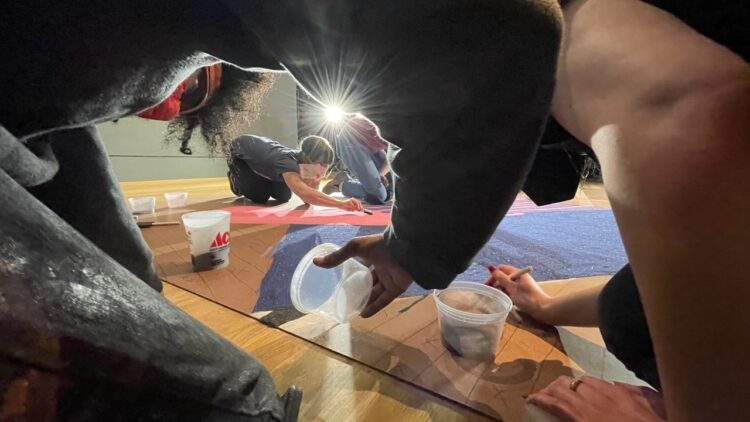Our latest Intersections project, Sanford Biggers: Mosaic, includes a site-specific floor installation made with sand. Five of the Phillips’s Museum Assistants—Rachel Cecelski, Jorge Vara Hernandez, Shawn Lindsay, Andreia Silva, and Emma Sweeney—were selected to help Biggers produce the work. Emma shares her impressions of the project.
Read Part I from Jorge and Rachel

Creating Sanford Biggers’s floor installation in Mosaic. Photo: Robin Bell
Emma Sweeney (@emma_sweeney_art_and_such), a graduate of the Corcoran College of Art and Design, works in drawing, painting, printmaking, and collage.
“After looking up images of Sanford Biggers’s previous sand installations, I was really excited to participate in creating this artwork. It was hard to imagine how such precise patterns could be created using a material as difficult to control as sand. What I learned over the course of the week that we spent creating Fool’s Folly is that you can get an incredible range of results from the simple act of pouring sand onto the floor.
We did not use any specialized tools, just quart-sized plastic containers and plastic putty knives from Home Depot. And yet with these simple means, I discovered that there were so many variables to experiment with: what height should you pour the sand from? Does tapping the container give you more control over how much sand comes out, or gently sifting it from side to side? What is the best way to hold the putty knife to minimize hand shaking? Each of us had to answer these questions for ourselves through trial and error to find which practices allowed us to uphold Sanford’s vision of the final piece.

Creating Sanford Biggers’s floor installation in Mosaic. Photo: Robin Bell
Our methods of working evolved over the course of several days as we all learned how to balance being precise with moving quickly enough to complete the installation on time. By the time it was complete I felt like I was only just beginning to get a handle on making the sand do exactly what I wanted it to, and a part of me wanted to keep going to see how much better at it I could get. Although my body, especially my knees, had definitely had enough by that point—my knees still aren’t talking to me after I put them through all that.
Overall, it was a very rewarding experience to see the artwork come together and to be a part of making it happen. It’s especially exciting to see the sand quilt in the gallery along with the Gee’s Bend quilts that inspired it, which have been some of my favorite pieces in The Phillips Collection since the museum acquired them.”
